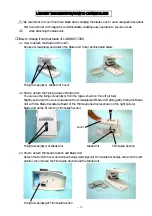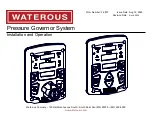
functions and operation modes such as the display indicating that the bat-
tery for the radio transmitter inside the CareMat is low.
More detailed information about the NurseCall 8 system is available on the
TeleAlarm SA web pages at www.telealarm.com.
Note
Once the CareMat has been paired with a radio receiver, these
components form a call system. Especially in cases where multiple
CareMat call systems are being used, we highly recommend label-
ling components that belong together to indicate this once teach-in
is complete. In this way, it can be ensured that the components are
not mixed up and that the call is only triggered in the particular
room where the CareMat and the associated radio receiver are also
actually located.
4
Maintenance and changing the radio transmitter battery
Fault finding
7
Technical data
8
6.1
Configuration / Teaching in the transmitter
6
Commissioning and maintenance
6.2
For the commissioning of the CareMat with the TeleAlarm
®
radio transmit-
ter, type UPCBA80, a corresponding radio receiver from the NurseCall 8 pro-
gram of the manufacturer TeleAlarm
®
is absolutely necessary. As the main
functions of this transmitter/receiver system are executed in the radio
receiver, please consult the radio receiver operating instructions to find the
steps required for commissioning.
For information on how to teach the CareMat into a radio receiver, consult
the appropriate operating instructions; this information can be found in
chapters covering programming or teaching in transmitters, for example.
If the instructions state that the transmitter button needs to be activated,
what this is referring to in the case of the CareMat with TeleAlarm
®
radio
transmitter type UPCBA80 is activating the CareMat. The CareMat is activat-
ed when it is stepped on or when a hand is pressed forcefully onto the active
switching surface.
The radio receiver operating instructions also explain how to connect radio
receivers to existing call systems. As well as this, they describe various
Article
CareMat
Ax1T
T868.8
/ Bx1T
T868.8
/ Cx1T
T868.8
Signalling protocol
TeleAlarm
®
NurseCall 8
Dimensions
(LxWxH)
1100 x 700 x 9 mm / 700 x 400 x 9 mm / 1100 x 700 x 9 mm,
height with housing 15 mm
Radio frequency
868.8 MHz
Weight [kg]
8.2 kg / 3.2 kg / 6.5 kg
Runtime, battery
Depending on use up to 2.5 years
Material
Polyurethane (PU)
Radio range
Up to 30 m in buildings, dependent on structural
building conditions (up to 100 m in free field)
Colour
Careyellow, Caregrey
Type of battery
1x CR2430, 3 V lithium
Surface
Stud texture design
Type of protection
IP54
Weight of persons
At least 10 kg
Ambient temperature
0 up to +55 °C
Chemical
resistance
Water (room temp.), body fluids, commercially available
disinfectants, max. 70 vol% alcohol
Subject to technical modifications
EU Declaration of Conformity
9
WEEE
10
BBC Bircher Smart Access,
BBC Bircher AG, Wiesengasse 20, CH-8222 Beringen, www.bircher.com
Designed in Switzerland / Made in Switzerland
Contact
11
Aside from changing the battery, the CareMat TeleAlarm
®
radio transmitter
type UPCBA80 is maintenance-free. To change the battery, proceed as follows:
•
Remove the housing cover on the rear of the CareMat (6 countersunk
screws M3 x 5, cross-head size PH1).
•
Carefully lift the transmitter board off the CareMat housing. Do not unplug
the cable connections.
•
As shown in the illustration remove the used battery and insert a new
battery type CR2430, 3 V lithium.
•
Reinsert the transmitter board into the CareMat housing and carefully
route the connection cables in the CareMat housing as before..
•
Reinstall the housing cover. Carefully tighten the 6 screws by hand;
do not overtighten.
If the system functions are not being provided, the user should check
the following:
•
Has another transmitter/receiver system been paired, or have any compo-
nents been mixed up?
•
Is the CareMat’s radio transmitter battery OK?
•
Has the information in the operating instructions for the radio receiver
been observed?
See attachment
Devices with this symbol must be treated separately during disposal. This must be done in accordance with the laws of the respective countries
for environmentally sound disposal, processing and recycling of electrical and electronic equipment.
•
If the system is being operated together with a call system: Is the radio
transmitter connected to the call system as specified?
If the points mentioned above have been checked out, but the system
functions are, despite this, still not being provided, you should consult
a qualified expert.
Use a thin pointed object (preferably plastic) to push the
battery out of the holder.
Insert the new battery with the + pole facing upwards.
2
1
1
1
2






























